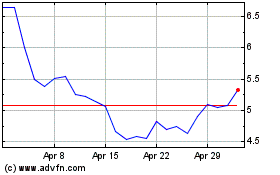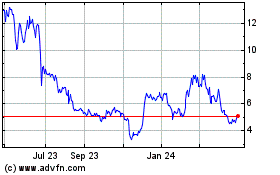Terns Pharmaceuticals, Inc. (“Terns” or the “Company”) (Nasdaq:
TERN), a clinical-stage biopharmaceutical company developing a
portfolio of small-molecule single-agent and combination therapy
candidates for the treatment of non-alcoholic steatohepatitis
(NASH) and other chronic liver diseases, today announced that
multiple presentations of positive results from clinical trials of
TERN-101 and TERN-501 will be delivered at The Liver Meeting®
Digital Experience 2021, the annual meeting of the American
Association for the Study of Liver Diseases (AASLD), which will be
held virtually from November 12-15, 2021.
An oral presentation titled “Liver-distributed FXR Agonist
TERN-101 Demonstrates Favorable Safety and Efficacy Profile in NASH
Phase 2a LIFT Study” will be delivered by Rohit Loomba, M.D., MHSc,
director of the UC San Diego NAFLD Research Center and director of
Hepatology at UC San Diego School of Medicine. This presentation
will highlight the safety and efficacy of TERN-101 after 12 weeks
of treatment in patients with NASH. TERN-101 was overall safe and
well-tolerated at all doses studied with no discontinuations due to
adverse events, including pruritus. In the TERN-101 5 and 10 mg
groups, no differences from placebo in percentage change in low
density lipoprotein (LDL) cholesterol or high density lipoprotein
(HDL) cholesterol from baseline to Week 12 were observed. TERN-101
demonstrated numerical reductions in alanine transaminase (ALT) and
MRI proton density fat fraction (MRI-PDFF) in the 10 and 15 mg
groups, and significant reductions in gamma-glutamyl transferase
(GGT) in all dose groups. Corrected T1 (cT1), a marker of liver
inflammation and fibrosis, declined significantly as early as Week
6 with persistent decreases through Week 12 in all TERN-101 groups
compared to placebo. These data support further clinical studies of
TERN-101 for the treatment of NASH, either alone or in combination
with other agents.
“These data add to the growing body of evidence supporting
TERN-101 as a potential treatment for NASH, a complex and
multi-faceted disease that currently has no available treatments
targeting all of the different underlying causes,” said Dr. Loomba.
“TERN-101 demonstrates a differentiated safety and efficacy
profile, including the potential to decrease liver inflammation and
fibrosis as measured by cT1, an increasingly recognized
non-invasive biomarker of fibro-inflammation.”
A second clinical presentation titled “Liver-distributed FXR
Agonist TERN-101 Leads to Corrected T1 (cT1) Response and a
Population Shift to Lower cT1 Risk Categories in NASH Phase 2a LIFT
Study” will be delivered by Eric Lawitz, M.D., director of the
Texas Liver Institute and Clinical Professor of Medicine at
University of Texas Health Science Center. This presentation will
detail the cT1 responses observed during the Phase 2a LIFT Study.
cT1 relaxation time, measured in milliseconds (msec), is a magnetic
resonance imaging-based test that is a composite biomarker of
inflammation and fibrosis. Mean cT1 values declined in a
significant and dose-dependent manner from baseline to Week 12 for
all TERN-101 doses. cT1 changes at Week 6 strongly correlated with
changes at Week 12. A higher proportion of patients treated with
TERN-101 for 12 weeks had a cT1 response (defined as a decrease ≥80
msec from baseline at Week 12) compared to placebo. TERN-101
treatment for 12 weeks also led to an increased proportion of cT1
low risk patients (where cT1<800msec), and a decreased
proportion of high-risk patients (where cT1>875msec). cT1 may
serve as a biomarker of TERN-101 treatment response as early as
Week 6. Overall, cT1 declines in the LIFT Study indicate
significant improvements in fibro-inflammation following TERN-101
treatment in NASH patients.
In addition, a third clinical presentation titled “Single Doses
of the THR-β Agonist TERN-501 are Well Tolerated and Result in
Dose-dependent Changes in LDL Cholesterol and Sex Hormone Binding
Globulin in a First-in-Human Clinical Trial” will be delivered by
Barry Crittenden, M.D., Executive Director, Clinical Research and
Medical Affairs at Terns. This presentation will highlight data
from the single ascending dose (SAD) cohort of TERN-501 up to 60
mg. All SAD doses of TERN-501 were overall safe, well-tolerated and
exhibited dose-proportional plasma exposures with low variability.
Significant decreases in LDL cholesterol, total cholesterol, and
apolipoprotein B were observed by Day 3 following single dose
administration of TERN-501 in one or more dose groups with
dose-dependent reductions on Day 4. TERN-501 also demonstrated
significant effects on sex hormone binding globulin (SHBG). SHBG is
a protein produced in the liver following activation of the thyroid
hormone receptor in hepatocytes and is a marker of THR-β target
engagement linked to NASH histologic efficacy. Significant
increases in SHBG were observed following a single dose of ≥10 mg
TERN-501 with dose dependent increases through 30 mg, indicating
potent target engagement at all evaluated dose levels. Importantly,
increases in SHBG have been associated with robust reductions in
MRI-PDFF and NAFLD Activity Score in a precedent late-stage
clinical NASH trial.
“Altogether, the multiple clinical data presentations at The
Liver Meeting demonstrate the tremendous progress made in the
advancement of Terns’ NASH pipeline. The data presented from our
Phase 2a LIFT study of TERN-101 continue to support the potential
of TERN-101 as a backbone of Terns’ combination strategy and the
utility of cT1 as an effective, non-invasive biomarker. Data from
our proof of concept Phase 1 clinical trial of TERN-501 released
earlier this week also demonstrated a potentially best-in-class
THR-β agonist profile, based on its significant increases in SHBG,
which has been shown to be linked to NASH histologic efficacy,”
said Erin Quirk, M.D., president, chief medical officer and head of
R&D at Terns. “We are pleased to share our TERN-101 and
TERN-501 data at The Liver Meeting as we look forward to Phase 1b
top-line data for TERN-201 in NASH patients in the first quarter of
2022 and the initiation of Terns’ first FXR / THR-β agonist
combination trial of TERN-101 with TERN-501 in NASH patients in the
first half of 2022.”
Oral Presentation:Title: Liver-distributed FXR
Agonist TERN-101 Demonstrates Favorable Safety and Efficacy Profile
in NASH Phase 2a LIFT StudyPublication Number: 143Session Title:
Parallel 21: NAFLD and NASH: Clinical Trials of Novel
TherapeuticsPresenting Author: Rohit LoombaDate and Time: Sunday,
November 14, 6:30 p.m. ETClinical Poster
Presentations:Title: Liver-distributed FXR Agonist
TERN-101 Leads to Corrected T1 (cT1) Response and a Population
Shift to Lower cT1 Risk Categories in NASH Phase 2a LIFT
StudyPublication Number: 1875Session Title: NAFLD and NASH:
Experimental: ClinicalPresenting Author: Eric Lawitz
Title: Single Doses of the THR-β Agonist TERN-501 are Well
Tolerated and Result in Dose-dependent Changes in LDL Cholesterol
and Sex Hormone Binding Globulin in a First-in-Human Clinical
TrialPresentation Number: 1889Session Title: NAFLD and NASH:
Experimental: ClinicalPresenting Author: D. Barry Crittenden
A full list of presentations can be found on The Liver
Meeting Digital Experience™ 2021 website.
About TERN-101TERN-101 is a liver-distributed,
non-bile acid FXR agonist that has demonstrated a differentiated
tolerability profile and improved target engagement, likely due to
its sustained FXR activation in the liver but only transient FXR
activation in the intestine. FXR is a nuclear receptor primarily
expressed in the liver, intestine and kidneys. FXR regulates
hepatic expression of various genes involved in lipid metabolism,
inflammation and fibrosis. Clinical studies of other FXR agonists
have demonstrated significant histological NASH improvements but
have also resulted in pruritus, adverse lipid changes and
discontinuations. Terns reported positive top-line results from the
Phase 2a LIFT Study of TERN-101 in June 2021.
About TERN-501TERN-501 is a thyroid hormone
receptor beta (THR-β) agonist with high metabolic stability,
enhanced liver distribution and greater selectivity for THR-β
compared to other THR-β agonists in development. Agonism of THR-β
increases fatty acid metabolism via mitochondrial oxidation and
affects cholesterol synthesis and metabolism. As a result, THR-β
stimulation has the ability to reduce hepatic steatosis and improve
serum lipid parameters including LDL cholesterol and triglycerides.
In vivo NASH studies in a rodent model have demonstrated that
low-doses of TERN-501 achieved complete resolution of steatosis and
reductions in serum lipids, hepatic inflammation and fibrosis.
TERN-501 has high liver distribution and is 23-fold more selective
for THR-β than for THR-α activation in a cell free assay, thereby
minimizing the risk of cardiotoxicity and other off-target effects
associated with non-selective THR stimulation. Finally, TERN-501
has been designed to be metabolically stable and is therefore
expected to have little pharmacokinetic variability and a low
clinical dose, making it an attractive candidate for use in
fixed-dose combinations for NASH treatment. Terns reported positive
top-line results from the proof of concept Phase 1 clinical trial
of TERN-501 in November 2021.
About Terns PharmaceuticalsTerns
Pharmaceuticals, Inc. is a clinical-stage biopharmaceutical company
developing a portfolio of small-molecule single-agent and
combination therapy candidates for the treatment of non-alcoholic
steatohepatitis, or NASH, and other chronic liver diseases. Terns’
pipeline includes three clinical stage development programs
including an FXR agonist, a VAP-1 inhibitor and a THR-β agonist,
and a preclinical GLP-1 receptor agonist program. Terns is focused
on developing combination therapies based on clinically validated
and complementary mechanisms of action to address the multiple
hepatic disease processes of NASH in order to drive meaningful
clinical benefits for patients. For more information, please visit:
www.ternspharma.com.
Cautionary Note Regarding Forward-Looking
StatementsThis press release contains forward-looking
statements about Terns Pharmaceuticals, Inc. (the “Company,” “we,”
“us,” or “our”) within the meaning of the federal securities laws,
including those related to the Company’s expectations of timing and
potential results of the Company’s clinical trials and other
development activities and the potential utility and progress of
the Company’s product candidates in NASH. All statements other than
statements of historical facts contained in this press release,
including statements regarding the Company’s strategy, future
financial condition, future operations, projected costs, prospects,
plans, objectives of management and expected market growth, are
forward-looking statements. In some cases, you can identify
forward-looking statements by terminology such as “aim,”
“anticipate,” “assume,” “believe,” “contemplate,” “continue,”
“could,” “design,” “due,” “estimate,” “expect,” “goal,” “intend,”
“may,” “objective,” “plan,” “positioned,” “potential,” “predict,”
“seek,” “should,” “target,” “will,” “would” and other similar
expressions that are predictions of or indicate future events and
future trends, or the negative of these terms or other comparable
terminology. The Company has based these forward-looking statements
largely on its current expectations, estimates, forecasts and
projections about future events and financial trends that it
believes may affect its financial condition, results of operations,
business strategy and financial needs. In light of the significant
uncertainties in these forward-looking statements, you should not
rely upon forward-looking statements as predictions of future
events. These statements are subject to risks and uncertainties
that could cause the actual results and the implementation of the
Company’s plans to vary materially, including the risks associated
with the initiation, cost, timing, progress and results of the
Company’s current and future research and development activities
and preclinical studies and clinical trials. In particular, the
impact of the COVID-19 pandemic on the Company’s ability to
progress with its research, development, manufacturing and
regulatory efforts, including the Company’s clinical trials for its
product candidates, will depend on future developments that are
highly uncertain and cannot be predicted with confidence at this
time, such as the ultimate duration of the pandemic, travel
restrictions, quarantines, social distancing and business closure
requirements in the United States and in other countries, and the
effectiveness of actions taken globally to contain and treat the
disease. These risks are not exhaustive. For a detailed discussion
of the risk factors that could affect the Company’s actual results,
please refer to the risk factors identified in the Company’s SEC
reports, including but not limited to its Annual Report on Form
10-K for the year ended December 31, 2020 and its Quarterly Reports
on Form 10-Q for the periods ended March 31, 2021 and June 30,
2021. Except as required by law, the Company undertakes no
obligation to update publicly any forward-looking statements for
any reason.
Contacts for Terns
InvestorsJustin Nginvestors@ternspharma.com
MediaJenna UrbanBerry & Company Public
Relationsmedia@ternspharma.com
Terns Pharmaceuticals (NASDAQ:TERN)
Historical Stock Chart
From Mar 2024 to Apr 2024

Terns Pharmaceuticals (NASDAQ:TERN)
Historical Stock Chart
From Apr 2023 to Apr 2024
